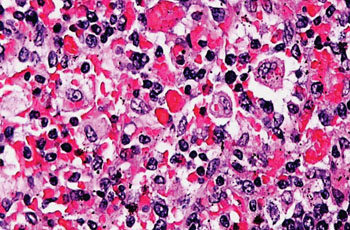Prognostic Factors in Children with HLH Investigated
By LabMedica International staff writers
Posted on 27 Oct 2016
Hemophagocytic lymphohistiocytosis (HLH) is a rare disease characterized by a rapidly fatal hematological disorder usually associated with malignancies and severe infections and it presents with prolonged high fever that could not be controlled by antibiotics.Posted on 27 Oct 2016
Other manifestations of HLH are hepatosplenomegaly, cytopenia, widespread infiltration with lymphocytes, and benign-looking histiocytes with hemophagocytosis in the bone marrow, liver, spleen, or lymph nodes. Early diagnosis and combined treatment can effectively control this life-threatening disease.

Image: A photomicrograph of a bone marrow showing stromal macrophages containing numerous red blood cells in their cytoplasm from a patient with hemophagocytic lymphohistiocytosis (Photo courtesy of Nephron).
Scientists at the Guangdong Medical College (Shenzhen, People’s Republic of China) carried out a retrospective analysis on HLH from January 1, 2000, to November 30, 2013. Of the 56 pediatric patients, 35 were boys and 21 were girls with a median age of 4.5 years (range: four months to 12 years) at the onset of HLH. The median duration before diagnosis of HLH was 1.5 weeks (range: one week to six weeks). The most common clinical symptoms observed were fever (100%), hepatomegaly or splenomegaly (95.24%), and pancytopenia (100%).
The team found that characteristic laboratory values presented with increased ferritin (64.29%), triglycerides (78.6%), transaminases (81%), bilirubin (67.5%), lactate dehydrogenase (95.2%), and decreased fibrinogen (61.9%), sodium (40.5%), and potassium (30.9%). Bone marrow aspiration showed hemophagocytosis in 48 cases (85.7%). Among the clinical and laboratory features analyzed, high lactate dehydrogenase (LDH) of greater than 2,000 U/L, high bilirubin of greater than 2 mg/mL, and younger age less than 2 years old at the time of diagnosis indicated worst outcome.
Anemia was observed in 39 patients (five cases with hemoglobin level less than 90 g/L, 27 cases less than 60–89 g/L, seven cases less than 30–59 g/L), neutropenia (neutrophil count less than 1.5×109/L) in 28 patients (22 cases less than 0.5–1.0×109/L, and five cases less than 0.5×109/L, and thrombocytopenia (platelet count less than 100×109/L) in 35 patients (33 cases with platelet count less than 20–99×109/L and two cases with platelet count less than 20×109/L). Examination of bone marrow aspiration showed hemophagocytosis in 48 (85.7%) patients.
The authors concluded that the etiology of HLH is complicated and early diagnosis is difficult. The level of LDH and bilirubin may predict the severity of HLH and depending on the clinical presentation, individualized therapy is needed for different patients. The study was published on October 11, 2016, in the Journal of Blood Medicine.
Related Links:
Guangdong Medical College














